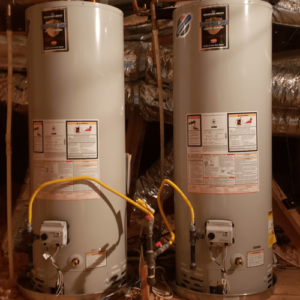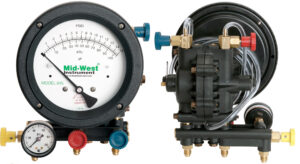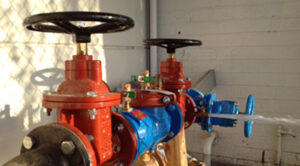If your water heater doesn’t produce hot water, make sure the circuit breaker and high-temperature cutoff switch aren’t tripped. If they are, resetting them may fix the problem.

If your hot water smells sulfurous or discolored, the dip tube could be faulty. A plumber should be able to replace it inexpensively. Contact Water Heater Repair Tampa for professional help.
Water heaters can cost homeowners a lot of money to replace, but they also can be incredibly expensive to repair. There are many common problems that can cause a hot water heater to stop working, such as rust or fractures. These issues are often difficult to fix, and it may be best to have a professional plumber take a look at the unit.
A clogged water heater can be costly to fix, especially if it is causing serious problems with your home’s plumbing system. Mineral buildups can create a layer of sediment in the tank, which makes it hard for water to reach the heating element. This can be difficult to fix, and can sometimes result in a burst water heater.
If you notice that your water has an odd smell or is discolored, it could be a sign that there’s an issue with your hot water heater. These problems can be caused by a variety of things, including leaks or a broken thermocouple.
Another issue is a faulty dip tube, which can cause cool water to mix in with your hot water. The dip tube is an inexpensive part, and you can usually replace it yourself by following the safe procedures outlined in the user’s manual.
Leaks are one of the most common problems that water heaters experience. These can be as simple as valves that need to be tightened or Teflon tape, but they can also be much more severe and require more extensive repair work. If you notice a leak, turn off your water supply and call a professional plumber ASAP.
A faulty or unresponsive pilot light can also be an easy problem to solve. The pilot light is simply a small light that signals when the unit is turned on and off, and can be easily replaced by following the safety instructions in the owner’s manual. However, the service call fee for a plumber to check the pilot light can be expensive. In addition, a gas water heater can be more expensive to repair than an electric model due to the complexity of its valves and thermostats.
Warranty
Warranties are promises from companies about the condition of goods and services they sell. They can be explicit or implied, and they are usually only valid for a limited time. Most states have laws that govern warranties, and they vary slightly from state to state. For example, in some states, a company must clearly explain its warranty terms in writing before the product is sold. Other states require that companies display the terms in plain sight and make them readily available to buyers before the sale is completed. In addition, some states require that companies inform consumers of their right to a refund or replacement if the warranty is not satisfied.
The best way to avoid unintentionally voiding a warranty is to read the fine print and follow all instructions provided by both the manufacturer and the service provider. If you have questions, don’t hesitate to contact the manufacturer or the service provider for clarification. By reading and following the terms of a warranty, you can save yourself money on future repairs or even avoid unnecessary costs entirely.
There are a number of potential problems with a water heater that may need repair. For instance, if you aren’t getting hot water, first check that the circuit breaker isn’t tripped. If it is, the problem could be a faulty heating element or a thermostat that’s malfunctioning. The tank might also be leaking or undersized.
Another possible issue is a tripped high-temperature limit switch on an electric water heater. This switch releases pressure from the tank if the temperature rises too high to prevent a fire or explosion. You can check this by shutting off the water and power to the unit, and removing the cover to see the switch.
In most cases, you can replace a broken water heater under homeowners’ insurance if it was damaged in a covered peril, such as a house fire or flood. However, water heater replacements aren’t always covered by homeowners’ insurance, so you should talk to your insurer about adding supplemental equipment breakdown coverage to your policy.
Safety
If you’re looking to repair or replace your water heater, you’ll need to take some important safety measures. These include clearing the area around the heater, using personal protective equipment, and turning off the power supply to the unit. These precautions will protect you from potential injuries and reduce the risk of fires or explosions.
Water heaters reach high temperatures, so it’s crucial to keep children and pets away from them during repairs. This will prevent them from getting scalded by hot water and from accidentally knocking over the appliance or causing other damage. You should also childproof the area by putting up gates or barriers to keep them from entering it.
You’ll need to wear personal protective equipment (PPE) when working on your water heater, such as a sturdy pair of gloves and goggles. The gloves will shield your hands from cuts and burns, while the goggles will protect your eyes from flying debris or chemical leaks. PPE is available from most hardware stores and home improvement centers.
Before you begin any work on your water heater, make sure it’s turned off and has cooled down completely. If you try to work on it while it’s still hot, you could be injured by severe burns or even cause a fire.
Another important step in water heater repair is to test the pressure valve. This valve is responsible for releasing excess pressure from the tank. If it’s damaged, you may experience a loud noise and see water leaking from the tank. If you notice this problem, call a plumber for repairs right away.
You should also check the temperature pressure relief valve once or twice a year, and have it replaced about every five years. This valve is a critical component of your water heater, so it’s important to have it inspected and repaired by a professional. A plumber will be able to determine if the valve is cracked or damaged and replace it if necessary. They’ll also be able to tell if the temperature is too high or low. If your water heater is in an uninsulated area of your home, it’s a good idea to install a thermal expansion tank to prevent overheating.
Efficiency
Most homeowners don’t give much thought to their water heaters as long as they function properly. However, if your water heater starts to wear out, it can have a big impact on your quality of life. Suddenly, it may not be possible to take hot showers or wash dishes.
Performing regular maintenance on your water heater can help extend its lifespan and detect problems that could otherwise go unnoticed. However, even with the best of care, your water heater will eventually need to be replaced. When this occurs, it’s important to compare the costs of repairing vs. replacing to determine which option is more cost-efficient for you.
The type of water heater you have will affect the repair costs as well. There are classic tank models in which heated water is stored until needed, as well as modern tankless units that heat water on demand. The price of repairs will also depend on whether your water heater is gas or electric.
If you’re experiencing issues with your water heater, it’s best to call a professional plumber right away. These professionals will inspect your unit and determine the cause of the problem. They will also recommend any necessary repairs or replacements. In addition, they can advise you on how to maintain your unit in the future to avoid future problems.
One of the most common reasons for a lack of hot water is that the heater is not sized properly for your household. This can be determined by a plumber and is typically a simple fix. The water heater should be sized for the number of people in your home and the typical amount of hot water used per day.
Another common issue is that the water heater’s temperature setting has been set too high. This can lead to scalding burns, so it’s important to keep the temperature at 120F or lower.
Lukewarm water from your water heater can also be caused by a number of factors, such as changes in the weather or increased usage. In this case, a plumber will likely suggest adjusting the settings on your water heater.



